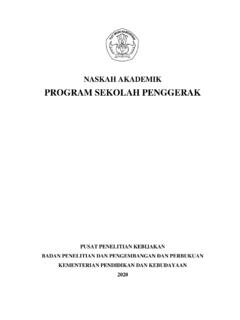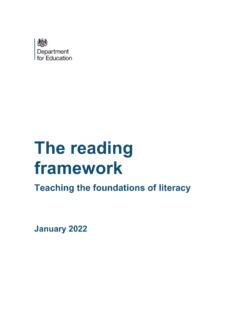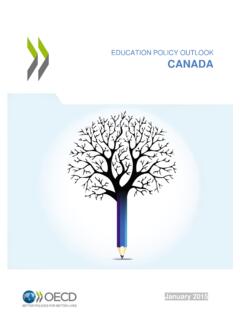Transcription of Education in Malaysia Towards a Developed Nation
1 Education in Malaysia Towards a Developed Nation Chang Da Wan National Higher Education Research Institute, Universiti Sains Malaysia Morshidi Sirat National Higher Education Research Institute, Universiti Sains Malaysia Dzulkifli Abdul Razak Universiti Sains Islam Malaysia & international Islamic University Malaysia September 2018 Abstract Education plays a key role in realising Malaysia s aspirations to be a Developed Nation . This paper provides a critical assessment of the state of Education in Malaysia . The issues that will be discussed in this paper includes the country s current ethos and philosophy of Education , technical and vocational Education (TVET), technology and flexible learning, and governance and financing of higher Education .
2 The paper also highlights critical omissions in the current Eleventh Malaysia Plan. Keywords: Education ; Malaysia JEL Classification: L52; L60 No. 2018 - 4 1 Education in Malaysia Towards a Developed Nation Chang Da Wan, Morshidi Sirat and Dzulkifli Abdul Razak 1. Introduction Dr Mahathir Mohamad articulated the Vision 2020 during his first term as Malaysia s Prime Minster. In Vision 2020, the goal was for Malaysia to become by year 2020 - a fully Developed Nation economically, politically, socially, spiritually, psychologically and culturally in terms of national unity, social cohesion, social justice, political stability, quality of life, social and spiritual value, and national pride and confidence (Mahathir 1991).
3 It was further articulated that by 2020, Malaysia should be a united Nation that is infused by strong moral and ethical values, living in a society that is democratic, liberal and tolerant, caring, economically just and equitable, progressive and prosperous, and in full possession of an economy that is competitive, dynamic, robust, and resilient (Mahathir 1991). Even though the Vision 2020 per se is no longer discussed much by the current government and policymakers, its lofty aspirations remain useful goals for Malaysia . In its original form, for the Vision to be realised, nine essential challenges that need to be overcome were Some of these challenges are economic in nature and hence should be incorporated in the country s existing development plans.
4 The latest of these plans, the Eleventh Malaysia Plan (11MP), is the most recent five-year economic plan. As rightly pointed out in the 11MP, the critical enabler in driving and sustain Malaysia s economic growth Towards the status of an advanced Nation is its people ( Malaysia , 2015).2 Yet, for Malaysia to fully realise its potential of a Developed Nation , whether it be by 2020 or after, it is necessary to go beyond the mere economic aspiration of having an efficient and effective labour market. In this paper, we argue that for Education to play its role as a critical enabler, there is a need to first re-humanise Education which involves going beyond the mere economic imperatives of 1 Challenge 1: Establishing a united Malaysian Nation .
5 Challenge 2: Creating a psychologically liberated, secure and Developed Malaysian society. Challenge 3: Fostering and developing a mature democratic society. Challenge 4: Establishing a fully moral and ethical society. Challenge 5: Establishing a matured liberal and tolerant society. Challenge 6: Establishing a scientific and progressive society. Challenge 7: Establishing a fully caring society. Challenge 8: Ensuring an economically just society, in which there is a fair and equitable distribution of the wealth of the Nation . Challenge 9: Establishing a prosperous society with an economy that is fully competitive, dynamic, robust and resilient.
6 2 The authors do not subscribe to the idea of human capital , which we argue de-humanises our discussion and understanding of Education . 2 producing skilled human capital for economic growth and higher income. Education , instead, guided by the National Philosophy of Education , must aim to develop a holistic person that is intellectually, spiritually, emotionally and physically balance and harmonious based on a firm belief in and devotion to God (MOE 2008). Thus, we maintain that only such a holistic focus on Education can propel Malaysia Towards becoming, not merely a high-income economy, but a truly Developed Nation . This paper discusses the state of Education in Malaysia .
7 It provides a critical assessment of the extent to which development in Education will be able to contribute Towards achieving the goals of Vision 2020. To enable a more contextualised discussion, the study will begin by examining the current state of Education from pre-school to higher Education , as well as the relevant plans in Education , especially in the recent decade. This is followed by a critical analysis of 11MP in terms of its focus and initiative in Education . 2. The State of Education in Malaysia Malaysia s achievement in Education enrolment is significant. Although pre-school Education is not compulsory in Malaysia , it was reported that almost 91 per cent of children at the age of four and five in the country were enrolled in some form of pre-school Education in 2014 ( Malaysia , 2015).
8 As for primary Education , for which enrolment is compulsory, Malaysia has achieved an enrolment rate of almost 98 percent; while in secondary Education the rate was 90 percent in 2014. In terms of post-secondary Education in 2016, 20,232 students were enrolled in public community colleges, 99,551 students in public polytechnics, 695,026 in private higher Education institutions (including colleges, university colleges, universities), and 532,049 across the twenty public universities in Malaysia (MOHE, 2017). In addition, there were also 98,379 registered Malaysian students studying abroad at the post-secondary level. As of 2012, the enrolment in tertiary Education for the age cohort of 18-23 years of age has achieved 48 per cent, a level that exceeded the universal target set by the World Bank and UNESCO.
9 The high enrolment in Education has, to a large extent, been adequately supported by existing educational facilities. As of 2014, there were 5,984 pre-school institutions across the country; of which 1,450 were located in urban areas and 4,534 in rural areas. There were 7,756 primary schools where 27 per cent of these schools were located in urban areas. In 3 terms of secondary schools, there were 2,376 schools with half of them in urban areas. These primary and secondary schools included government and government-aided schools; more precisely, the national, national-type (vernacular), religious, technical, vocational, special Education , sports, and arts schools (MOE 2015b).
10 To date, there are twenty public universities (including five research universities, four comprehensive universities, and eleven focused universities in fields of technical, Education , management and defence), fifty-three private universities with seven branch campuses of foreign universities, twenty-six private university colleges, thirty public polytechnics, eighty public community colleges and more than 350 private colleges. Although Malaysia s Education enrolment figures are remarkable, there is still a vast room for improvement qualitatively. For example, in the case of students progressing through primary and secondary schools, there is an absence of a mechanism (such as examinations) to assess and determine progression.







